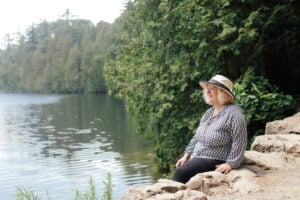The current epoch is going on 11,700 years now, but this week, leading geologists from around the world will argue that human impact on Earth’s life systems has created a new epoch on the geologic time scale in just 70.
Humans seem to be having a disproportionately fast and intense impact on our planet, potentially on a scale equivalent to the mass extinctions during the Devonian period that wiped out many coral reefs, shellfish and early fishes. Humans are innovative and industrious, but we have a big footprint.
“We have taken hold of the key physical forces that control life on Earth,” says Alexander Wolfe, adjunct professor of paleobiology at the University of Alberta. For example, through construction and agriculture, humankind transports more rock and sediment around the globe than all other natural processes combined. We continue to alter the carbon cycle enough to cause global warming at a time when the planet should be gradually cooling. In trying to meet global demands for food, we have used fertilizer so excessively that we’ve disrupted natural feedback and control systems.
We are now having an effect on the planet that may someday be as measurable in the rock and dirt layers of Earth’s history as the fossilized bones of dinosaurs. This is what Wolfe and 37 international colleagues hope to prove to the International Union of Geological Sciences at their annual meeting, taking place this week in Cape Town, South Africa, as they formally propose the designation of a new epoch on the geological time scale: the Anthropocene.
Their argument hinges on evidence of human activity in the biostratigraphic record, or sediment layers made up of the remains of animal and plant life, as well as soil particles and other non-biological material around it. These layers accumulate over time to form a continuous archive of the environment and climate.
Radioisotopes began to accumulate in this record after the United States’ first nuclear test in 1945, in New Mexico (known as the Trinity Test), and peaked in 1963 with an intense period of nuclear weapons testing before the Partial Nuclear Test Ban Treaty came into effect the same year. They provide a novel and lasting legacy that points to the possible boundary between the most recent epoch, the Holocene, and the Anthropocene.
Another vestige of human impact in this growing archive is the ubiquitous presence of fly ash in lake sediment cores from around the world. Fly ash is emitted into the atmosphere when coal is burned, and circulates the globe on far-reaching atmospheric currents. It began to accumulate noticeably around the 1950s when the use of coal increased to meet higher demand for electricity and fuel-oil combustion was introduced. In a recent study, data from more than 75 lake sediment records from Greenland to the United States, Eurasia to the Antarctic show a synchronous record of fly ash across the planet. This accumulation speaks to the larger issue of global airborne pollutants.
But not everyone is convinced there’s scientific justification for a new epoch. Stan Finney is a professor of geological sciences at California State University and the chair of the International Commission on Stratigraphy, one of the official committees that will review the Anthropocene proposal. He says the biostratigraphic evidence put forward by the working group is minimal and doesn’t qualify under the criteria suggested in the International Stratigraphic Guide.
The units traditionally recognized by the commission are based on a sedimentary rock record, says Finney. The proof that the Anthropocene working group has accumulated in reference to the past six decades is represented largely in loose sediments in lakes and in ice cores. In other words, he feels it’s not a sufficient rock-equivalent.
Of course, if current trends continue, carbon levels in the atmosphere will continue to grow. Glaciers will continue to shrink, and sea levels will keep rising. We get these messages from climate scientists, concerned citizen groups and media, some of whom may not even be aware of the term Anthropocene, much less the debate about it becoming an official epoch. This begs the question: What’s in a name? If the Anthropocene working group succeeds in finding a home for this new epoch on the geological time scale, how will its formal designation contribute to the conversation about anthropogenic changes in a way that’s different from how these issues are already talked about?
“If we keep using ‘Holocene’ as the label for this time, it’s as if we’re saying nothing has changed. But the planet has changed geochemically. It is not what it was a hundred years ago,” says Simon Donner, an associate professor of atmosphere and ocean science at the University of British Columbia who studies the impact of climate change on marine ecosystems.
He doesn’t think the term will serve people outside the scientific community, at least not right away. He does think, however, that it’s important for scientists to consider how they talk about issues — not because they’re going to be on the front page of every newspaper the next day, but because in making these changes, they eventually filter out into society.
“Labels matter,” he says. “The name we use for something has influence on how we perceive it.”
This story has been excerpted from a feature that appeared in the June 2016 issue of Canadian Geographic.
Related: A Q&A about the Anthropocene with limnologist John Smol




